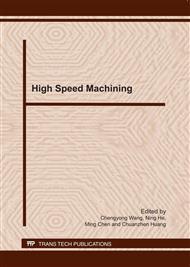p.32
p.38
p.43
p.49
p.55
p.61
p.67
p.73
p.78
Cutting Force, Cutting Temperature and Tool Wear in End Milling of Powder Metallurgy Nickel-Based Superalloy FGH95
Abstract:
FGH95 is one kind of high-strength, thermal-resistant nickel-based superalloys fabricated by powder metallurgy (PM). It plays an increasingly important role in the development and manufacture of turbine discs. Due to the extreme toughness and work hardening characteristics of this kind of superalloy, the problem of machining FGH95 is one of ever-increasing magnitudes. This paper investigates the influence of cutting parameters on the cutting force, cutting temperature and tool wear during the end milling of PM nickel-based superalloy FGH95. The empirical formula for cutting force and cutting temperature of FGH95 are given out. Experimental results show that the cutting speed among milling parameters has the greatest influence on cutting forces and cutting temperatures. It is shown that the major tool wear mechanisms are combination interactions of abrasive wear, adhesion wear, micro-breakout and chipping.
Info:
Periodical:
Pages:
55-60
Citation:
Online since:
March 2011
Authors:
Price:
Сopyright:
© 2011 Trans Tech Publications Ltd. All Rights Reserved
Share:
Citation:


